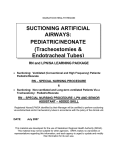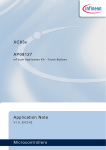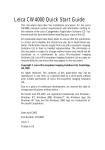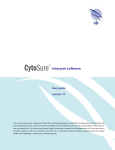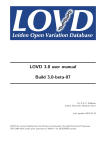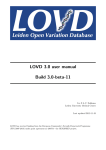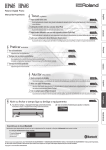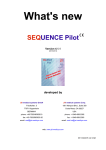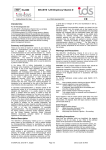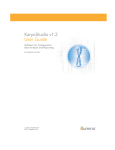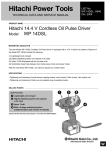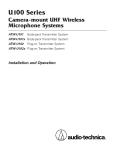Download HGMD_global_document - BIOBASE Biological Databases
Transcript
®
QIAGEN HGMD 2015
HGMD® Professional 2015.3 Global Documentation
Sample to Insight
Contents
Introduction ........................................................................................................................ 4
Citing HGMD® ........................................................................................................... 4
Rationale ................................................................................................................. 4
Data coverage ........................................................................................................... 4
Evidence for pathological authenticity ............................................................................... 5
Data collection .......................................................................................................... 6
Curation policy .......................................................................................................... 6
Mutation categories .............................................................................................................. 8
Missense/nonsense ..................................................................................................... 8
Splicing ................................................................................................................... 8
Regulatory ................................................................................................................ 9
Small deletions .......................................................................................................... 9
Small Insertions ......................................................................................................... 9
Small Indels ............................................................................................................. 9
Other mutation types................................................................................................... 9
Sub-categorisation of data ................................................................................................... 10
Disease-associated polymorphism (DP) ......................................................................... 10
Disease-associated polymorphism with supporting functional evidence (DFP) ........................... 10
In vitro/laboratory or in vivo functional polymorphism (FP) ................................................ 10
Disease causing mutation? (DM?) .............................................................................. 10
Disease causing mutation (DM) .................................................................................. 10
Retired entry (R) .................................................................................................... 10
Inclusion Criteria for Disease-associated/Functional polymorphisms .......................................... 11
Other Categories of Variation ....................................................................................... 13
Web Interfaces (HGMD® PRO + HGMD® Advanced) ................................................................ 15
HGMD® PRO searches ............................................................................................... 15
Gene search ....................................................................................................... 16
Mutation search ................................................................................................... 18
Phenotype search……………………………………………………………………………………………………….19
Reference search ................................................................................................. 19
HGMD® Global Documentation
09/2015
2
Batch search ....................................................................................................... 20
Other search options ............................................................................................. 20
F.A.Q. search ..................................................................................................... 21
HGMD® Advanced searches ......................................................................................... 22
Nucleotide Substitutions PLUS search ........................................................................ 23
Micro-lesions (Insertions, Indels and Deletions <21bp) search ....................................... 29
Quick search (Search in both Nucleotide substitutions and Micro-lesions) ......................... 30
MutationMart: batch mode search ............................................................................. 31
Gene-based search .............................................................................................. 32
Genome-interpretation and NGS-based analysis using HGMD ® Advanced ........................... 32
Mutation Viewer ........................................................................................................ 37
Copyright Notice ................................................................................................................ 40
References ....................................................................................................................... 41
HGMD® Global Documentation
09/2015
3
Introduction
Citing HGMD®
If you refer to HGMD® in any publication, please cite:
Stenson PD, Mort M, Ball EV, Shaw K, Philips A, and Cooper DN (2014), The Human Gene Mutation Database:
building a comprehensive mutation repository for clinical and molecular genetics, diagnostic testing and personalized
genomic medicine. Hum Genet 133:1-9.
Rationale
Human gene mutation is a highly specific process, and this specificity has important implications for the nature,
prevalence and therefore diagnosis of genetic disease. Indeed, the recognition that certain DNA sequences are
hypermutable has yielded clues as to the endogenous mutational mechanisms involved and provided insights into the
intricacies of the processes of DNA replication and repair (Cooper and Krawczak 1993). In practical terms, a fuller
understanding of the mutational process may prove important in molecular diagnostic medicine by contributi ng to
improvements in the design and efficacy of mutation search procedures and strategies in different genetic disorders.
The Human Gene Mutation Database (HGMD ®) represents an attempt to collate known (published) gene lesions
responsible for human inherited disease. This database, whilst originally established for the study of mutational
mechanisms in human genes (Cooper and Krawczak 1993), has now acquired a much broader utility in that it
embodies an up-to-date and comprehensive reference source to the spectrum of inherited human gene lesions. Thus,
HGMD® provides
information
of
practical
diagnostic
importance to (i)
researchers
and
diagnosticians
in human
molecular genetics, (ii) physicians interested in a particular inherited condition in a given patient or family, (iii)
genetic counsellors, (iv) personal genomics and NGS researchers.
Data coverage
The Human Gene Mutation Database includes the first example of all mutations causing or associated with human
inherited disease, plus disease-associated/functional polymorphisms reported in the literature. HGMD ® may also include
additional reports for certain mutations if these reports serve to enhance the original entry (e.g. functional studies).
These data comprise various types of mutation within the coding regions, splicing and regulatory regions of human
nuclear genes. Somatic mutations and mutations in the mitochondrial genome are thus not included, although in the
latter case, links to Mitomap are provided. Each mutation is entered only once in order to avoid confusion between
recurrent and identical-by-descent lesions.
HGMD® Global Documentation
09/2015
4
HGMD® does not usually include mutations lacking obvious phenotypic consequences although a few such variants have
been included where they could conceivably have some clinical effect (e.g. albumins, butyrylcholinesterases). Many
published mutation searches identify more than one genetic change in a single patient. In such cases, the relationship
between a given lesion and the clinical phenotype is not always immediately clear, and the curators of HGMD® have
had to rely exclusively upon the judgements of authors, peer reviewers and journal editors. The possibility of
unintentional inclusion of some lesions with little or no pathological significance can therefore not be ruled out.
HGMD® includes disease-associated/functional polymorphisms. To be included, there must be a convincing association
of the polymorphism with the disease/functional phenotype. More information on this can be found in the polymorphism
inclusion criteria.
Evidence for pathological authenticity
Pathological mutations that dramatically disrupt the structure of a given gene are self-evidently very likely to be
responsible for the associated clinical phenotype. However, for other categories of lesion, pathological mutations are
often difficult to distinguish from polymorphisms with little or no clinical significance, particularly if their structural o r
functional consequences are subtle (Cotton and Scriver, 1998). Evidence for their authenticity in a pathological context
therefore usually comes from one or more different lines of evidence:
Absence in normal controls.
Novel appearance and subsequent cosegregation of the lesion and disease phenotype through the family pedigree.
Absence of any other lesion in the gene that could be responsible for the observed clinical phenotype.
Previous independent occurrence in an unrelated patient.
Non-conservative amino acid substitutions are more likely to disrupt protein function.
Location in a protein region of known structural or functional importance.
Location in an evolutionarily conserved nucleotide sequence and/or amino acid residue.
In vitro demonstration of reduced gene expression/mRNA splicing/activity or stability of protein product consequent
to mutation.
Demonstration that the mutant protein has the same properties in vitro as its in vivo mutant counterpart.
Reversal of the pathological phenotype in patient/cultured cells by gene replacement.
Despite the best efforts of the HGMD ® curators, it may be assumed that some categories of gene lesion listed in
HGMD® (e.g. missense mutations, regulatory mutations, splicing mutations) are likely to include entries that are not
actually causative even though they have been reported as such. In some cases the evidence for pathogenicity may
be dubious; such variants can be identified by the addition of a question mark (?) to the given disease/phenotype,
which indicates that some degree of uncertainty is involved.
HGMD® Global Documentation
09/2015
5
Data collection
Data are collected by the manual and computerised screening of journals and publicly available locus specific databases
(LSDBs). Where possible, data are included from the original reports; entries are referenced to 'Mutation Updates'
and review articles if the original publication is not available. Please note that ambiguously-described mutations are not
included in the database until clarification has been obtained from the authors.
Curation policy
Disease-causing mutations are entered into HGMD ® where the authors of the associated reference indicate that the
alteration
described
confers
the
clinical
phenotype
polymorphisms (DPs) are entered into HGMD
®
specified
upon
the
individuals
concerned.
Disease-associated
where there is evidence for a significant association with a clinical or
laboratory phenotype along with additional evidence that the polymorphism is itself of likely functional relevance (e.g.
missense change, alters transcription factor/miRNA binding site etc.). Functional polymorphisms (FPs) are entered into
HGMD® where the authors have demonstrated that the polymorphism in question exerts a direct functional effect (e.g.
as evidenced by a luciferase reporter gene assay). Disease-associated polymorphisms with supporting functional
evidence (DFPs) must meet both of the above criteria.
The HGMD® curators have adopted a policy of continual assessment of the curated content with respect to the
mutation entries in the database. If and when additional important new information pertaining to a specific mutation
entry becomes available (e.g. questionable pathogenicity, confirmed pathogenicity, additional phenotypes, population
frequency, functional studies etc.), the mutation entry may be revised or recategorized. Alternatively, a comment or
additional reference may be added in order to communicate this new information to users. Where new information
becomes available which suggests that a given disease-causing mutation (DM) entry is likely to be of questionable
pathological relevance or even a neutral polymorphism (on the basis of additional case reports, genome/population
screening studies etc.), it may be flagged with a question mark (DM?) or even retired from the database entirely if
it turns out to have been erroneously included ab initio.
The majority of clinical phenotypes assigned to DMs in HGMD ® represent rare conditions that most people would
consider to be “diseases”. However, it is important to note that HGMD ® also considers a “silent” protein deficiency or
biochemical phenotype (e.g. butyrylcholinesterase deficiency, reduced oxygen affinity haemoglobin etc.) to be worthy of
inclusion since they are potentially disease-relevant (even if they are relatively common in the general population).
Such variants may well be assigned to the DM category.
HGMD® users should not assume that just because a mutation is labelled "DM", that it automatically follows that the
HGMD® curators are certain that the mutation is disease causing in all individuals harbouring it (i.e. that this mutation
is deemed to be fully penetrant). As geneticists, we know that this is not invariably going to be the case. Indeed, it
is likely that next generation sequencing programmes (such as the 1000 Genomes Project) will identify considerable
numbers of "DM" mutations in apparently healthy individuals (MacArthur et al. 2012). Such lesions should not be
HGMD® Global Documentation
09/2015
6
regarded automatically as being clinically irrelevant because it is quite possible that these mutations may be low penetrance or late onset disease susceptibility alleles rather than neutral variants. It has always been HGMD® policy to
enter a variant into the database even if its pathological relevance may be questionable (while indicating this fact to
our users wherever feasible), rather than run the risk of inadvertently excluding a variant that may be directly relevant
to disease.
HGMD® Global Documentation
09/2015
7
Mutation categories
Table 1. Summary of mutation categories in HGMD®
Types
Description
Genomic
coordinates
HGVS
Web interface
Missense/nonsense
Single base-pair substitutions in coding regions
YES
YES
HGMD PRO and ADVANCED
Splicing
Single base-pair substitutions with consequences for mRNA
splicing
YES
YES
HGMD PRO and ADVANCED
Regulatory
Single base-pair substitutions causing regulatory abnormalities
YES
NO
HGMD PRO and ADVANCED
Small deletions
Micro-deletions (20 bp or less)
YES
YES
HGMD PRO and ADVANCED
Small insertions
Micro-insertions (20 bp or less)
YES
YES
HGMD PRO and ADVANCED
Small indels
Micro-indels (20 bp or less)
YES
YES
HGMD PRO and ADVANCED
Gross deletions
Deletions over 20 bp
NO
NO
HGMD PRO
Gross insertions
Insertions over 20 bp
NO
NO
HGMD PRO
Complex rearrangements
Recorded in narrative format
NO
NO
HGMD PRO
Repeat variations
Recorded in narrative format
NO
NO
HGMD PRO
All HGMD® entries comprise a reference to the first literature report (primary reference) of a mutation, the associated
disease state as specified in that report, and the gene name and official symbol (as recommended by the HUGO
Gene Nomenclature Committee; HGNC). In cases where no official gene symbol exists, a provisional symbol has been
assigned by the HGMD® curators, which is denoted by lower-case letters.
NCBI dbSNP numbers (where identified) may also be recorded. The inclusion of a dbSNP identifier for a HGMD ®
entry in no way implies that the entry in question is a polymorphism.
Missense/nonsense
Single base-pair substitutions in coding regions are presented in terms of the triplet change.
Splicing
Single base-pair substitutions with consequences for mRNA splicing are presented as the nucleotide change and the
position relative to the donor or acceptor splice site of a specified intron. Positions given as positive integers refer to
a 3' (downstream) location and negative integers refer to a 5' (upstream) location.
HGMD® Global Documentation
09/2015
8
Regulatory
Substitutions causing regulatory abnormalities are logged with thirty nucleotides of upstream and downstream flanking
sequence; the location of the mutation relative to the transcriptional initiation site, start codon or termination codon is
given.
Small deletions
Micro-deletions (of 20 bp or less) are presented with the deleted bases in lower case plus, in upper case, 10
bases of sequence flanking both sides of the lesion. The numbered codon is preceded in the given sequence by the
caret character ("^"). Where deletions occur outside the coding region of the gene, other positional information is
occasionally provided e.g. 5' UTR (5' untranslated region) or E6I6 (denotes exon 6/intron 6 boundary).
Small Insertions
Micro-insertions (of 20 bp or less) are shown with the inserted bases in lower case and 10 bases of upstream and
downstream sequence (in upper case). The numbered codon is preceded in the sequence by the caret character
("^"). Where insertions extend outside the coding region, other positional information may be provided e.g. 3' UTR
(3' untranslated region) or E12I12 (denotes exon 12/intron 12 boundary).
Small Indels
Micro-indels (of 20 bp or less) are presented with the deleted bases in lower case flanked by, in upper case, 10
bases of upstream and downstream sequence. The inserted nucleotides are shown in lower case. The numbered codon
is preceded in the given sequence by the caret character ("^"). Where the lesion occurs outside the coding region
of the gene, other positional information is occasionally provided e.g. c.252-32_-28 to indicate that the deleted bases
occur at the -32_-28 positions relative to the exon starting at c.252.
Other mutation types
For gross deletions, gross insertions, repeat variations and complex rearrangements, information regarding the nature
and location of a lesion is logged in narrative form because of the extremely variable quality of the original data
reported.
HGMD® Global Documentation
09/2015
9
Sub-categorisation of data
Disease-associated polymorphism (DP)
A polymorphism reported to be in significant association with a disease/phenotype (p<0.05) that is assumed to be
functional (e.g. as a consequence of location, evolutionary conservation, replication studies etc.), although there is as
yet no direct evidence (e.g. from an expression study) of functional effect.
Disease-associated polymorphism with supporting functional evidence (DFP)
A polymorphism reported to be in significant association with disease (p<0.05) for which evidence of direct functional
importance (e.g. as a consequence of altered expression, mRNA studies etc.) has been presented (either in the
original report or in a subsequent study, which will be included as a secondary reference).
In vitro/laboratory or in vivo functional polymorphism (FP)
A polymorphism reported to affect the structure, function or expression of the gene (or gene product), but with no
disease association reported as yet.
Disease causing mutation? (DM?)
Likely pathological mutation reported to be disease causing in the corresponding report, but where the author has
indicated that there may be some degree of doubt, or subsequent evidence has come to light in the literature, calling
the deleterious nature of the variant into question.
Disease causing mutation (DM)
Pathological mutation reported to be disease causing in the corresponding report (i.e. all other HGMD ® data).
Retired entry (R)
An entry retired from HGMD® due to being found to have been erroneously included ab initio, or subject to correction
in the literature resulting in the record becoming obsolete, merged or otherwise invalid.
HGMD® Global Documentation
09/2015
10
Inclusion Criteria for Disease-associated/Functional polymorphisms
Aim
HGMD® seeks to include DNA sequence variants that are either (i) disease-associated and of likely functional
significance, or (ii) of clear functional significance even though no associated clinical phenotype may have been
identified to date. In order to deal with published polymorphism reports describing potential disease associations in a
methodical and uniform manner we have adopted the inclusion criteria set out below.
Background
At present, ~58% of the polymorphic variants recorded in HGMD ® are ‘disease-associated’. However, even in cases
where no disease association has yet been demonstrated, functional polymorphisms that alter the expression of a gene
or the structure/function of the gene product are potentially very important. Although a functional polymorphism with no
disease association may not have any direct and/or immediate clinical relevance, these data are potentially very
valuable in terms of understanding inter-individual differences in disease susceptibility. The vast majority of polymorphic
variants in HGMD® are single nucleotide polymorphisms (SNPs) but a small number are of the insertion/deletion type.
The polymorphic variants logged in HGMD ® are generally located in either regulatory or coding regions of genes
although it should be noted that SNPs occurring outside of these regions may nevertheless still have consequences for
gene expression, splicing, transcription factor binding etc.
Definitions
The distinction between a disease-associated polymorphism and a pathological mutation is in practice often fairly
arbitrary and is generally made in the context of the prevalence of the variant in the population as well as its
penetrance (the frequency with which a specific genotype manifests itself as a given clinical phenotype). Variants with
a minor allele frequency of >1% in the population being studied are, by convention, termed polymorphisms. These
polymorphisms are identified in the database by the addition of ‘association with’ and ‘association with?’
to the
clinical/laboratory phenotype description (the question mark indicates that the association is judged by the HGMD ®
curators to be somewhat tenuous).
HGMD® Global Documentation
09/2015
11
Polymorphic variants logged in HGMD ® usually fall into two discrete categories:
Disease-associated polymorphisms of presumed or proven functional significance (DP or DFP)
To be included as disease-associated, a statistically significant (p<0.05) association between the polymorphism and a
clinical phenotype must have been reported. In addition, other information (e.g. in vitro or in vivo expression/functional
data, replicated association studies, epidemiological studies, evolutionary conservation data etc.) should have been
made available to support the contention that the polymorphism in question is itself of bona fide functional significance.
Such a polymorphism (DP) could have consequences for gene expression, protein structure/function, gene splicing,
etc. These supporting experimental data are required to ensure that non-causative variants (i.e. those merely in
linkage disequilibrium with the actual causative variants) are not included. If the functional data required to support the
inclusion of a disease-associated variant are contained in a subsequent article, the primary reference logged in HGMD®
will be that in which the disease association was reported, with the paper containing the functional evidence being
given as a secondary reference (‘Functional characterisation’).
Polymorphisms of functional significance with no reported disease association (FP)
If no clinical phenotype is known to be associated with a polymorphic variant, but sufficient in vitro or in vivo
expression/functional data1 have nevertheless been presented to indicate functional significance, then the variant will be
included in HGMD®. Typically, such data provide evidence for a direct effect on gene expression, protein structure
and/or function, gene splicing etc. These variants can thus, in a very real sense, be considered as giving rise to a
‘deficiency’ (or occasionally a surfeit) of a given gene transcript or protein product. The phenotype recorded in
HGMD® would give a brief description of the functional effect e.g. ‘Reduced gene expression, association with’. If, at
a later date, evidence becomes available to indicate that a disease/clinical phenotype is associated with
the
polymorphism, the ‘functional’ phenotype will be replaced by the disease/clinical phenotype, with the corresponding
paper added as the primary reference.
The earlier functional report will be included as a secondary reference and the
entry will be re-categorised as “DFP”. Polymorphic variants affecting individual drug responses, patient survival times
after diagnosis, and responses to surgical intervention, are not included in HGMD ®. Studies which simply report dbSNP
numbers in association with disease (e.g. from large scale genome-wide association studies), with no additional
evidence of direct functional involvement are also not included in HGMD ®. Users interested in this particular category of
variation
should
try
other
databases
such
as
the
Catalogue
of
Published
Genome-Wide
Association
Studies
(http://www.genome.gov/26525384/) or the Genetic Association Database (http://geneticassociationdb.nih.gov/).
One caveat to bear in mind is that in vitro studies are not invariably accurate indicators of the in vivo situation [see
for example Cirulli and Goldstein (2007) & Dimas et al. (2009)].
In some instances, the above criteria may
be only
partially satisfied,
such that
the HGMD ® curators
remain
unconvinced as to the functional/phenotypic relevance of the variant reported. In such cases, the polymorphism may be
included as a result of (i) supporting information becoming available subsequent to publication of the original (first)
HGMD® Global Documentation
09/2015
12
report, or (ii) because the associated gene/disease state was deemed to be of sufficient importance for the variant
to warrant further study. Such variants have been ascribed the descriptor ‘association with?’ (as opposed to
‘association with’ without a question mark) to indicate that some degree of uncertainty is involved.
Replication studies for disease-associated polymorphic variants
The replication of disease-association studies can be a source of additional information to satisfy the inclusion criteria.
If a replication study serves to support a previously tenuous genotype-phenotype correlation, then the phenotype can
be ‘promoted’ from ‘association with?’ to ‘association with’ and the replication study will be added as a secondary
reference.
HGMD® wild type and mutant alleles may be reversed
In HGMD® the mutant allele is recorded as the allele responsible for the reported disease/phenotype. In some HGMD ®
records (typically polymorphism data, where both the wild type and mutant allele may be found at high frequency),
the wild type as given by RefSeq may be the same as HGMD ® mutant allele; this is so we preserve the relationship
between reported disease/phenotype and mutant allele.
Other Categories of Variation
Copy number variations
Copy number variations (CNVs) are DNA segments >1 kb in length that present with variable numbers of copies in
a given population. These variants are being reported in the literature with an ever increasing frequency. CNVs are
potentially functionally significant and should therefore in principle be treated by HGMD ® in a similar manner to any
other polymorphism. However, human CNVs are already being collected by other databases such as the Database of
Genomic
Variants
(http://projects.tcag.ca/variation/)
and
the
Human
Genome
Structural
Variation
Project
(http://humanparalogy.gs.washington.edu/structuralvariation/). CNVs that are disease-associated are also being collated
in databases such as DECIPHER (http://www.sanger.ac.uk/PostGenomics/decipher/), the European Cytogeneticists
Association
Abnormality
Register
Database
of
Unbalanced
Chromosome
Aberrations
(http://www.ukcad.org.uk/cocoon/ukcad/).
excellent curatorial work of other organisations, HGMD
®
(http://www.ecaruca.net)
Whilst
HGMD
®
does
not
and
wish
the
to
Chromosome
replicate
the
is still interested in such variants if they are shown to be both
of functional significance and associated with disease, and if they involve a single characterised gene that is itself
clearly involved in the disease association.
Risk haplotypes
Reports of haplotypes associated with an increased risk of disease are not included in cases where there is no
indication as to precisely which variant (or variants) within the haplotype is (are) responsible for the disease
HGMD® Global Documentation
09/2015
13
association/functional effect. If, however, evidence is presented to support the contention that a single variant within
the risk haplotype is causative and/or of functional significance to a degree which satisfies the inclusion criteria, then
it would be included in HGMD ®.
HGMD® Global Documentation
09/2015
14
Web Interfaces (HGMD® PRO + HGMD® Advanced)
Have I got the right browser?
The HGMD® web pages should work correctly with any modern browser. These include the most popular browsers
such as Microsoft Internet Explorer, Mozilla, FireFox and Opera. Text-only browsers such as Lynx can also operate
HGMD® correctly although some pages will look odd.
We are working toward making our code compliant with HTML v5. If your browser is not capable of this, it will only
mean that the presentation on your screen is not identical to ours. The results generated from search requests should
not be affected.
Can I bookmark a particular page?
With web browsers it is possible to 'bookmark' individual pages from HGMD. However, we do not recommend th is as
not only are you likely to miss important notices placed on the HGMD ® home page, but we reserve the right to
change the internal structure of the database as required.
HGMD® PRO searches
There are five primary searches in HGMD® PRO: Gene, Mutation, Reference, Batch and Advanced. The Gene and
Reference searches support Boolean searching, with the use of wildcards (*). UK and US spelling variations are
accepted; for example, both "haemophilia" and "hemophilia" will return the F8 and F9 genes. Please note that
alternate spelling functions only for whole words.
Boolean fulltext searching
+ operator indicates that the search term must be present in each result.
e.g. +breast +cancer returns results where both breast and cancer are present.
- operator indicates that the search term must not be present in any result.
e.g. -breast +cancer returns results that contain cancer but not breast.
* operator serves as the truncation (or wildcard). Unlike the other operators, it should be appended to the word to
be affected.
HGMD® Global Documentation
09/2015
15
e.g. poly* returns results such as polyposis, polycystic and polypeptide.
" operator when used to enclose your search terms means that the search terms are treated literally (as they were
typed).
e.g. "hum mutat" will return results containing the exact phrase "hum mutat".
Note1: If Boolean operators are not utilised, then multiple search terms are treated by a Boolean search as separate
entities (e.g. a search for breast cancer without quotes [""] will return all results containing breast OR cancer.
Note2: HGMD® fulltext searching in MySQL has a minimum word length of 4 characters by default. Any search terms
entered with less than 4 characters may not be recognised by the HGMD ® fulltext search engine.
Non-boolean searching
This type of search works in a different way to the Boolean fulltext search. The fulltext index is not utilised, therefore
there is no minimum word length in force (2 and 3 character searches will function). No operators are used, and
multiple search terms will be treated as a literal phrase. Partial matches will also be returned by the search (except
for the HGNC/OMIM/GDB/Entrez ID search, will return exact matches only).
Search for the word transporter.
Returns results where the word transporter is present. Will also return partial matches such as transporters and
cotransporter.
Search for the words prostate cancer.
Returns results where the words prostate cancer occur as a literal phrase.
Search for the gene symbol APC.
Returns results where APC occurs, including the APC gene itself, plus partial matches e.g. APCDD1 and PROC
(where APC is an alias).
Note: This search does not utilise an index, and therefore may be somewhat slower than a Boolean fulltext search.
Gene search
Enter search term:
The genes present in HGMD® may be found by utilising seven different search options.
HGMD® Global Documentation
09/2015
16
1. All fields search - Searches for your search terms in all fields listed below at once (2-7).
2. Gene symbol search - Searches HGMD® for the official HUGO Gene Nomenclature Committee gene symbol. Any
gene symbol aliases that have been identified are also be included in this search.
Official symbol example: 'ABCC2'
Gene symbol alias example: 'MRP2'
3. Gene description search - Searches HGMD® for the official HUGO Gene Nomenclature Committee gene name. Any
gene name aliases that have been identified are also be included in this search.
Official description example: 'ATP-binding cassette, sub-family C (CFTR/MRP), member 2 (CMOAT)'
Gene description alias example: 'Canalicular multispecific organic anion transporter'
4. Chromosomal location search - Searches HGMD® for the chromosomal location of HGMD ® genes.
Example: '10q24'
5. HGNC/OMIM/GDB/Entrez ID - Searches HGMD® for the gene identifiers assigned by the HUGO Gene
Nomenclature Committee database, Online Mendelian Inheritance in Man, the Genome Database (legacy only) and
the Entrez Gene database.
HGNC Example: '5384'
OMIM Example: '601107'
GDB Example: '6089489'
Entrez Example: '1244'
6. Disease/phenotype search - Searches HGMD® for the disease/phenotype associated with reported mutations in
HGMD® genes.
Example: 'Dubin-Johnson syndrome'
7. Gene ontology search - Searches for the ontology terms that have been assigned (by the Gene Ontology
Consortium) to the genes present in HGMD®.
Example: 'organic anion transmembrane transporter activity', 'GO:0008514' or '0008514'
Detailed results will contain a list of gene information, diseases and external links/IDs associated with your search
terms. Concise results are limited to gene information (symbol, description, chromosomal location) only.
To access the HGMD® record for a gene, click on the gene symbol listed. Some portions of the returned text may
be highlighted in green. This indicates the part of the results that matches the search terms.
Secondary gene search
Symbol:
The secondary search allows users to go directly to a particular gene if the gene symbol is known. This search will
only function with the correct HUGO Nomenclature Committee gene symbol.
HGMD® Global Documentation
09/2015
17
Mutation search
There are five ways HGMD® may be searched for specific mutations.
1. Codon number search - Searches for mutations affecting a particular codon in the coding region. This search will
return results from the missense/nonsense, small deletions, small insertions and small indels mutation categories.
Results will contain a list of genes/diseases with links to both the gene page and specific mutations found during
your search. For small deletions, small insertions and small indels, the codon number searched is that of the first
affected codon, not the last whole codon as marked by "^" in the HGMD® entry (i.e. - in the entry CD010589
AAAS 156 TTGCGT^GTCTttGCATGGCACC, the first affected codon is 157). Please note that this search will not
pick up mutations either beginning or wholly within an intron as there will not be a first affected codon to search
for.
Example: '157'
NOTE: You can restrict your search to disease causing mutations or disease-associated/functional polymorphisms. The
default is to search both types. Please note that for convenience, "frameshift or truncating variant" is included under
both types.
2. Accession number search - Searches HGMD® for specific accession numbers (if known). Partial accession
numbers will be accepted (with wildcards *). Results will contain a list of genes with links to both the gene
page and specific accession number(s) found during your search.
Example: 'CM035497' or 'CM035*'
3. Search using official HGVS mutation nomenclature - Searches HGMD® for mapped mutations using the official
nomenclature as described by den Dunnen and Antonarakis (2001). This search includes only the
missense/nonsense mutations, small deletions, small insertions and small indels that have been mapped to the
genome. Please note that for deletions, insertions and indels, HGVS nomenclature requires that the most 3’
affected nucleotides are specified.
Example: '298C>T' or 'R100X'
Example: '20_21delTT' or '20_21del2' or '20_21del'
Example: '104_105insAA' or '104_105ins2' or '104_105ins' and '2195_2198dupAACA' or '2195_2198dup4' or
'2195_2198dup'
Example: '385_386delAGinsGTT' or '385_386del2ins3' or '385_386delins'
4. Search using dbSNP identifier - Searches HGMD® for mutations that have a corresponding entry present in the
NCBI dbSNP database. Partial 'rs' numbers will be accepted (with wildcards checked).
Example: 'rs1799963'
Example: 'rs1042522'
5. Search using chromosomal coordinates - Searches HGMD® for mutations using chromosomal coordinates. This
search includes only then missense/nonsense mutations, small deletions, small insertions and small indels that have
HGMD® Global Documentation
09/2015
18
been mapped to the genome (the February 2009 build; GRCh37/hg19). Users may enter a coordinate range, a
single coordinate or an entire chromosome.
Example: 'chr1:2327114_2333800'
Example: 'chrX:77130681_77132008'
Example: 'chr7:1942983'
Example: 'chr2'
Phenotype search
There are two ways HGMD® may be searched for phenotypes.
1. HGMD phenotype search - Searches the phenotypes recorded in HGMD directly. The phenotypes present in
HGMD are generally recorded as they were initially reported in the corresponding literature article.
Example: 'Cancer'
NOTE: You can restrict your search to disease causing mutations or disease-associated/functional polymorphisms. The
default is to search both types. Please note that for convenience, "frameshift or truncating variant" is included under
both types.
2. UMLS semantic search - Searches mapped UMLS ontology which includes OMIM, SNOMED CT and MeSH
terms.
Example: 'Cutis laxa'
Results will contain an alphabetical list of HGMD phenotypes and genes associated with your search term.
You also have the ability to browse the phenotypes found in HGMD alphabetically (A-Z), by chromosome, or by mapped UMLS
ontologies (currently OMIM, SNOMED CT, MeSH and MTH terms).
Reference search
There are six ways HGMD® may be searched for references.
1. All fields search - Searches for your search terms in all fields listed below (2-6).
2. First author search - Searches HGMD® for the first author (surname) of the mutation references found in
HGMD®.
Example: 'Edwards'
3. PubMed journal search - Searches HGMD® for the PubMed journal title abbreviations associated with the mutation
references found in HGMD®. Full journal names may also be used.
HGMD® Global Documentation
09/2015
19
Example: 'Am J Hum Genet' or 'American journal of human genetics'
4. PubMed ID search - Searches HGMD® for PubMed IDs associated with the mutation references found in HGMD ®.
Example: '9042910'
5. Publication year search - Searches HGMD® for the specific years in which the mutation references found in
HGMD® were published.
Example: '1997'
6. HGMD® gene search - Searches HGMD® for the gene symbols associated with the mutation references found in
HGMD®.
Example: 'TCOF1'
Results will contain a list of genes and references associated with your search terms. To access the HGMD ® record
for that gene, click on the gene symbol listed. You may also view the PubMed record (if available) associated with
each search result.
Secondary reference search
Medline journal abbreviation:
The secondary search allows users to retrieve all data derived from a particular journal.
HGMD® Global Documentation
09/2015
20
Batch search
The batch search can be used to search for up to 500 variant or gene identifiers. Users should paste or type their
list of identifiers into the search box (one per line), use the radio buttons to indicate the type of identifier, and
Submit query.
1. dbSNP - Searches for variants with specified dbSNP 'rs' identifiers.
Example: 'rs6025'
2. Chromosomal coordinate - Searches for variants with specified chromosomal coordinates (GRCh37/hg19).
Example: 'chr1:169519049'
3. Variant Call Format (VCF) – Searches for variants with specified v4.0 compliant VCF. The CHROM, POS, ID,
REF and ALT (tab-delimited) fields are relevant here.
Example: '1 2338019 ID1 CAG C . . .'
4. HGMD accession - Searches for variants with specified HGMD® accession numbers.
Example: 'CM940389'
5. PubMed ID – Searches by variants derived from specified PubMed identifiers.
Example: '24077912’
6. HUGO gene symbol - Searches for genes with specified HUGO Nomenclature Committee gene symbols.
Example: 'F5'
7. HUGO gene ID - Searches for genes with specified HUGO Nomenclature Committee gene identifiers.
Example: '3542'
8. Entrez Gene ID - Searches for genes with specified Entrez Gene identifiers.
Example: '2153'
9. OMIM ID - Searches for genes with specified OMIM gene identifiers.
Example: '612309'
Other search options
The ability to browse HGMD ® genes by gene symbol (A-Z), chromosomal location (1-22, X and Y), or to view
pre-queried HGMD® data (a random HGMD® gene entry, genes newly added for the current release, genes updated
with new mutation data for the current release, genes by total number of mutations, or genes sorted by ontology
term) is also available.
HGMD® Global Documentation
09/2015
21
F.A.Q. search
The HGMD® Frequently Asked Questions (accessed through the Information menu) may be searched for keywords, or
retrieved in its entirety. Boolean operators may be used (see above) and, as with HGMD® searching, there is a
minimum word length in force, usually of 4 characters.
General remarks
Firstly, always make sure you are searching with the correct option selected. You cannot use a gene symbol search
to find a disease. If you are getting error messages you need to alter your search strategy. If you are getting too
many "gene not found" errors when searching for gene symbols, you should try searching alternate fields instead. For
example, CD95 is the old symbol for FAS. It will not appear in a gene symbol search, but it will appear in a gene
description
or
alias
search.
If
you
are
not
getting
the
results
required
when
using
a
gene
description
or
disease/phenotype search, you can try to narrow your search. For example, entering "cancer" as a disease/phenotype
search term will produce too many results. Narrowing it to something like "gastric cancer" may produce the desired
results. Note also that there is a minimum word length of 4 characters for HGMD ® searching, so entering any term
with less than that will not produce any results.
HGMD® Global Documentation
09/2015
22
HGMD® Advanced searches
Search types
The HGMD® Advanced Search has five different interfaces:
1. Nucleotide Substitutions PLUS search
2. Micro-lesions search
3. Quick search
4. MutationMart
5. Gene-based search
3
5
1
2
4
Figure 1. Access to HGMD® Advanced Search Interface
HGMD® Global Documentation
09/2015
23
Nucleotide Substitutions PLUS search
Overview
The Nucleotide Substitutions PLUS search allows all HGMD® single-base substitutions (missense/nonsense, regulatory
and splicing) to be interrogated via one interface.
The mutation types used by this search have been mapped onto genomic reference sequences (hg19) to allow
flexible data-mining and motif-searching for transcription factors, conserved DNA domains or user-defined motifs.
Filters
Figure 2. Nucleotide Substitutions PLUS Interface
HGMD® Global Documentation
09/2015
24
How do I search?
Nucleotide Substitutions can be mined using one or more of the following categories:
Motif Search
Base Substitution
Amino Acid Substitution
Splicing
Regulatory
Other
Motif Search
Using the drop-down box predefined motifs can be selected or a user-defined motif can be typed into the text field
to the side of the drop-down box.
The user-defined motif can be defined by using regular expressions. Some characteristics of extended regular
expressions are:
‘.’ matches any single character.
A character class ‘[...]’ matches any character within the brackets. For example, ‘[abc]’ matches ‘a’, ‘b’, or ‘c’. To
name a range of characters, use a dash. ‘[a-z]’ matches any letter, whereas ‘[0-9]’ matches any digit.
Example 1: The regular expression [CA][CA]AGGTAGGTAA would match to the 5' splice site consensus sequence.
Example 2: The regular expression [GC]ATG would match to both GATG and CATG.
Example 3: The regular expression [AG][CT][AG] would match the sequence RYR.
Note - the motif search feature is not case sensitive and single letter codes are not supported.
If the check-box ‘Created’ is selected then all substitutions that create this motif will be returned.
If the check-box ‘Abolished’ is selected then all substitutions that disrupt this motif will be returned.
Base Substitution
Using the drop-down menus the wild type and/or the mutant nucleotides can be selected.
HGMD® Global Documentation
09/2015
25
Amino Acid Substitution
Using the drop-down menus the wild type and/or the mutant amino acids can be selected.
Splicing
Mutations that have been shown to affect splicing can be searched for by:
Entering an intron number into the ivs text box.
The site of the substitution can be selected (either donor or acceptor splice site).
The location relative to the splice site can also be selected.
Other
Select the field to search from the list. Enter the search term in the text field. If the 'Fuzzy Search' check box is
selected then wildcards will be added to the beginning and end of the search term.
Combining of the “other” option with the categories listed above will narrow the results to e.g. to a certain
disease/phenotype or gene.
Filters
Advanced Search Results can be filtered by mutation type:
Missense/nonsense
Regulatory
Splicing
Advanced Search Results can also be filtered by variant class:
Disease-causing mutations
Disease-associated polymorphisms
Functional polymorphisms
HGMD® Global Documentation
09/2015
26
Output Fields:
1. Mutation type e.g. regulatory
2. Variant class e.g. DM
3. HGMD® id
4. dbSNP
5. Functional profiling result
6. Disease/Phenotype
7. Gene symbol
8. Entrez gene id
9. Link to PROTEOME locus report
10. HGVS nomenclature
11. Mutation description
12. Genomic coordinates (hg19 default)
13. MutPred
14. SIFT
15. Genomic sequence context
16. Primary Reference
17. Mutation viewer link
Functional Profiling of Mutation Data
HGMD® is in the process of annotating variants with both in vitro/in vivo and in silico data to help in the
ascertainment of the molecular mechanism underlying the functional effect of a given mutation.
When this process has been completed, HGMD ® aims to annotate mutation data for over 40 different types of
functional site including exonic splice enhancers (ESE), post-translational modification sites and numerous transcription
factor binding sites (TFBS) etc.
Please see the following paper for more information:
Mort M, Evani US, Krishnan VG, Kamati KK, Baenziger PH, Bagchi A, Peters BJ, Sathyesh R, Li B, Sun Y, Xue
B, Shah NH, Kann MG, Cooper DN, Radivojac P, Mooney SD: In silico functional profiling of human diseaseassociated and polymorphic amino acid substitutions. Hum Mutat. 31(3):335-346
HGMD® Global Documentation
09/2015
27
Access to the functional profiling search tools is via the 'Nucleotide Substitutions Plus' Search.
An example functional profiling search:
Search for HGMD® regulatory variants disrupting transcription factor binding sites (TFBS) from TRANSFAC. Select
'TFBS' from functional profiling drop down menu (Figure 3Figure 3).
Figure 3. Drop down functional profiling menu from Nucleotide Substitutions PLUS
Functional sites disrupted by the mutation in question are shown in the functional Profile column (Figure 4, highlighted
by red box).
Figure 4. Functional profiling results
Clicking on the relevant functional site shows the functional profiling mutation report (Figure 5) which displays both in
vitro/in vivo and in silico evidence (where available) for any functional site disruption.
HGMD® Global Documentation
09/2015
28
Figure 5. Functional profiling mutation report
Ability to download results (Figure 6):
1. Results downloaded as a tab delimited file
2. Genome browser track using hg19 coordinates
1
2
Figure 6. Downloading results from an Advanced Search query
HGMD® Global Documentation
09/2015
29
Micro-lesions (Insertions, Indels and Deletions <21bp) search
This category comprises all small deletions, small insertions and small indels. This allows data-mining to be performed
on a number of fields including deletion size, insertion size and user-defined motifs. Search results are available to
download, using the same method as with the Nucleotide Substitutions Plus search.
Figure 7. Micro-lesions search page
Output fields include:
Mutation type, HGMD® ID, dbSNP, Disease/Phenotype, Gene, HGVS, Genomic coordinates, Sequence context, codon,
Deleted bases, Inserted bases, Nucleotide, Reference
HGMD® Global Documentation
09/2015
30
Quick search (Search in both Nucleotide substitutions and Micro-lesions)
With the Quick search, selected fields in different tables (Nucleotide substitutions and Micro-lesions) can be searched
at the same time. This search also queries the title of the original mutation report for key words.
This search option is especially useful to get a quick overview of the information available in different tables, e.g. for
a certain disease.
The Quick search results are ranked by relevance and are assigned a Ranking rating. The 'quick search' ranking score
relates to the number of matches found for the query keyword(s) across the gene symbol, disease term, title of
mutation report, abstract of mutation report and dbSNP identifier fields. The higher the score the more relevant the
mutation to the query keyword(s).
Japanese
Figure 8. HGMD® Advanced Quick Search
HGMD® Global Documentation
09/2015
31
Quick search examples
Example 1: Enter 'Japanese' as the search term (Figure 8).
This returns all mutations linked to a Mutation Report with 'Japanese' in the title and/or 'Japanese' in the Gene or
Disease fields.
Example 2: Enter 'stroke candidate gene' as the search term.
This returns all mutations linked to a Mutation Report with 'stroke candidate gene' in the title and/or 'stroke candidate
gene' in the Gene or Disease fields.
MutationMart: batch mode search
HGMD® can be queried in a batch mode using three different types of identifier:
1. dbSNP identifier e.g. rs1800072
2. PubMed identifier e.g. 20981092
3. Entrez gene identifier e.g. 1080
Up to 50 identifiers can be queried at once (place each identifier on a new line).
MutationMart Results can be downloaded to a tab delimited text file.
HGMD® Global Documentation
09/2015
32
Figure 9. Description of the MutationMart
Gene-based search
Clicking on a chromosome identifier (1-22, X, Y, MT) will return a list of all the genes on that chromosome
recorded in HGMD®. The list will include links to the Mutation Viewer for the genes in which substitutions, small
deletions, small insertions and/or small indels in the coding region are recorded.
Genome-interpretation and NGS-based analysis using HGMD® Advanced
HGMD® Advanced provides a collection of utilities to assist in the analysis of NGS data:
1. Results from the Nucleotide Substitutions PLUS search, Micro-lesions search and Mutation Mart can be exported
into custom genome browser tracks to allow importing into other software tools such as the UCSC genome browser
and Genome Trax.
2. Functional profiling of mutation data to identify the underlying molecular mechanism including the mapping of HGMD ®
variants to TFBS from Transfac.
3. Providing annotations from SIFT (Sorting Intolerant From Tolerant).
4. Providing annotations from MutPred.
HGMD® Global Documentation
09/2015
33
Option 1: Exporting HGMD® data to other applications (e.g. Genome Trax or UCSC) by creating a Custom Genome Browser
Track
Step 1: Creating your HGMD® Custom Genome Browser Track
Use the Advanced Search to generate your search query.
Click submit and navigate to results page
Click download results as genome browser track (Figure 10Error! Reference source not found.)
Save custom genome browser track to your computer (Hint: remember where you save it)
Figure 10. Download custom Genome Browser track
Step 2: Importing your HGMD ® Custom Genome Browser Track into an external program (e.g. UCSC genome browser
or Genome Trax)
Navigate to UCSC genome browser gateway (http://genome.ucsc.edu/cgi-bin/hgGateway)
Click manage/add custom tracks (Figure 11Error! Reference source not found.)
Figure 11. Adding a custom track at UCSC Genome Browser
HGMD® Global Documentation
09/2015
34
Step 3: Finding the Custom Genome Browser track to upload.
Click Browse (Figure 12) and upload previously saved browser track
Click submit
Figure 112. Uploading the custom Genome Browser track
Step 4
Your track should now be imported.
Click “go to genome browser” (Figure 13Error! Reference source not found.).
Figure 123. Imported track
HGMD® Global Documentation
09/2015
35
Step 5: View your custom track in the genome browser (Figure 14Error! Reference source not found.).
HGMD data
Figure 134. An Advanced Search result been viewed on the UCSC genome browser
Note: Large custom tracks may take a while to load.
HGMD® custom annotation tracks can be viewed only on the machine from which they were uploaded and are
automatically deleted if unused for 48 hours. The HGMD® custom annotation tracks are for the sole use of HGMD ®
Professional subscribers.
Tools used to predict harmful missense mutations (SIFT and MutPred)
HGMD® missense mutations have been annotated with two different tools which predict the pathogenicity of missense
mutations. The MutPred tool also makes predictions about the underlying molecular mechanism disrupted, e.g. loss of
phosphorylation site.
SIFT (Sorting Intolerant From Tolerant)
SIFT predicts whether an amino acid substitution (AAS) affects protein function based on sequence homology and the
physical properties of amino acids (NG and Henikoff 2001). For disease-causing (DM) missense mutations in
HGMD® around 80% are predicted to be deleterious by SIFT. An AAS with a SIFT score of less than 0.05 is
predicted to be deleterious, one with a score greater than or equal to 0.05 is predicted to be tolerated. For more
information please refer to the SIFT website (http://sift.jcvi.org/www/SIFT_help.html).
HGMD® Global Documentation
09/2015
36
MutPred
The MutPred Score is the probability (expressed as a figure between 0 and 1) that an AAS is deleterious/diseaseassociated. A missense mutation with a MutPred score > 0.5 could be considered as 'harmful', whereas a MutPred
score > 0.75 should be considered a high confidence 'harmful' prediction.
The MutPred hypothesis refers to the underlying structural and functional properties that the missense mutation impacts
upon. The accompanying P-value indicates the assigned probability that the specified structural or functional property
has been impacted upon by the mutation (a P value <0.05 indicates a statistically significant probability). Around
20% of missense mutations in HGMD ® have been assigned a MutPred hypothesis. For more information please refer to
the MutPred website (http://mutpred.mutdb.org/about.html).
HGMD® Global Documentation
09/2015
37
Mutation Viewer
The Mutation Viewer depicts coding region mutations superimposed on the cDNA sequence of a gene. The Mutation
Viewer is a Java Applet and requires at least Java version 1.5 to be installed. Note: splicing mutations are not
supported by the Mutation Viewer.
The wild-type cDNA sequence is represented in black whilst the mutated nucleotides are shown in different colours.
Nucleotide Substitutions are shown in RED.
Deletions are shown in BLUE.
Insertions are shown in MAGENTA.
Indels are shown in GREEN.
The amino acid sequence annotation of the wild-type cDNA can be switched on and off with the Show Amino Acids
button.
Figure 14. CFTR gene as displayed by the Mutation Viewer
HGMD® Global Documentation
09/2015
38
Mutation Viewer examples
Nucleotide Substitution: Example Leu-Arg CTT-CGT codon 51.
Insertion: Example CCTGAAA^GATagatATTAATTTCA ^codon 94
Deletion: Example CGATT^GAAGaagCAATGGAA codon 141
HGMD® Global Documentation
09/2015
39
Indel: Example ATTT^CCCtgggctGTA codon 59 Insert A
HGMD® Global Documentation
09/2015
40
Copyright Notice:
The Human Gene Mutation Database constitutes the intellectual property of Cardiff University. Any unauthorised copying,
storage or distribution of this material without written permission from the curators would lead to copyright infringement
with possible ensuing litigation. Copyright © Cardiff University 2011. All Rights Reserved.
HGMD® Global Documentation
09/2015
41
References
Stenson PD et al. (2014), The Human Gene Mutation Database: building a comprehensive mutation repository for
clinical and molecular genetics, diagnostic testing and personalized genomic medicine. Hum Genet 133:1-9.
Cooper DN et al. (2013), Where genotype is not predictive of phenotype: towards an understanding of the molecular
basis of reduced penetrance in human inherited disease. Hum Genet 132:1077-1130.
MacArthur DG et al. (2012), A systematic survey of loss-of-function variants in human protein-coding genes.
Science 335:823-828.
Dimas AS et al. (2009), Common regulatory variation impacts gene expression in a cell type-dependent manner.
Science 325: 1246-1250.
Stenson PD et al. (2008), The Human Gene Mutation Database (HGMD ®): 2008 Update. Genome Med 1(1):13.
Cirulli ET and Goldstein DB (2007), In vitro assays fail to predict in vivo effects of regulatory polymorphisms. Hum
Mol Genet 16: 1931-1939.
Balakirev ES and Ayala FJ (2003), Pseudogenes: are they "junk" or functional DNA?. Ann Rev Genet 37: 123-51.
Ng PC and Henikoff S (2001), Predicting deleterious amino acid substitutions. Genome Res. 11:863-74.
den Dunnen JT and Antonarakis SE (2001), Nomenclature for the description of human sequence variations. Hum
Genet 109: 121-24.
Cotton RG and Scriver CR (1998), Proof of "disease causing" mutation. Hum Mutat 12:1-3.
Krawczak M and Cooper DN (1995), Core database. Nature 374(6521): 402
Cooper DN and Krawczak M (1993), Human Gene Mutation. BIOS Scientific Publishers, Oxford.
HGMD® Global Documentation
09/2015
42










































